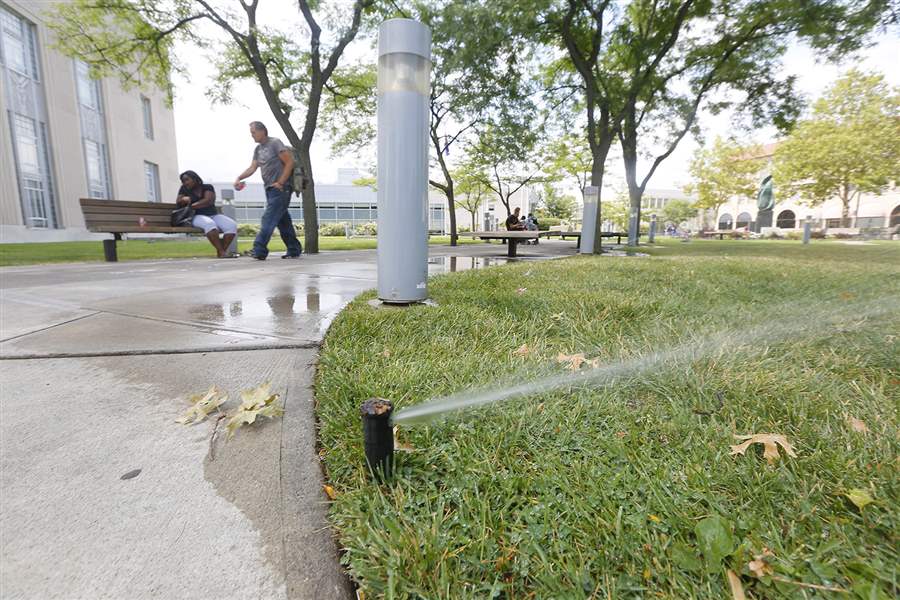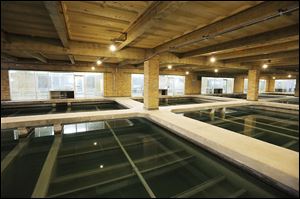
IS TOLEDO ANSWERING THE CALL FOR CONSERVATION?
Treatment plant back to full strength after fix
Some react slowly to plea for water savings
8/7/2014
Sprinklers water the lawn at the Main Toledo-Lucas County Library downtown on Wednesday.
THE BLADE/AMY E. VOIGT
Buy This Image

Sprinklers water the lawn at the Main Toledo-Lucas County Library downtown on Wednesday.
Toledo’s water treatment plant is fully operational now that a repair to the flocculator basin expected to take four days was completed in just 24 hours.
The request by Mayor D. Michael Collins for residents and businesses to conserve water, however, is still in effect.
“The repair was successful, and the basin is refilled,” Toledo Public Utilities Director Ed Moore said.
Mr. Moore said the four-day estimate for repairing the flocculator, one of six at the plant that mixes raw water from the lake with treatment chemicals that help remove sediment and algae, was conservative.
“When we got a chance to look at it, it wasn’t as bad as we thought,” he said.
COMMENTARY: During water crisis, Toledo failed on public relations front
The mayor urged residents on Tuesday to conserve water for the rest of the summer as the toxic algae bloom in Lake Erie remains a threat to the city’s drinking-water supply.
A day after lifting the do-not-drink warning, Mr. Collins told city water customers they should take shorter showers, wash only full loads of laundry and dishes, and operate washing machines and dishwashers on their most energy-efficient modes.
Reducing stress
Water conservation is necessary to reduce stress on the Collins Park Water Treatment Plant, where toxic microcystin from lake algae contaminated the drinking water during the weekend, affecting about 500,000 customers.
Mr. Moore said the daily testing for microcystin will continue until the end of the algae bloom season. On Wednesday microscystin levels were “undetectable,” he said.
The water levels at the treatment plant fluctuate daily and hourly, but a comparison of average water use on Wednesday — the first day of the conservation period — to Tuesday seemed to indicate water use decreased.

The fountain at One Government Center downtown was shut off Wednesday afternoon, part of a symbolic gesture for water conservation.
City water customers used about 67 million gallons on Wednesday. That number was just over 86 million gallons on Tuesday, he said. The plant is designed produce 120 million gallons per day.
“Hopefully, people listened to what we are saying and that usage has gone down, and we hope our citizens will continue to conserve,” Mr. Moore said.
Getting started
There has been some confusion in the public about how long the conservation period should last. The city of Sylvania posted a message on its Web site urging residents to reduce water use for the next four days, the period of time the mayor initially said would be needed to repair the plant.
Mr. Moore said, however, that water users need to refrain from watering their lawns or irrigating fields and washing cars at home until the end of September.
It took some time Wednesday for conservation efforts to get off the ground at some of the largest businesses and institutions in Toledo. The water fountain in the plaza in front of One Government Center, which houses city and county offices including the mayor, continued to flow earlier in the day but was turned off later in the afternoon.
The city asked the state Department of Administrative Services, which manages One Government Center, to shut off the fountain, said the mayor’s spokesman, Lisa Ward. The state agency turned off the fountain as a symbolic show of support because it uses recirculated water and doesn’t draw water from the city system, Ms. Ward said.
The sprinkler system was also on at the Main Toledo-Lucas County Library downtown, but Susan Gibney, marketing manager, said they were testing the sprinkler and that all the branches will comply with the conservation effort.
The irrigation system was watering the grass downtown at the Lucas County Courthouse on Wednesday morning. County Administrator Laura Lloyd-Jenkins said the county will cut back watering from five days a week to three days at the courthouse, the 6th District Court of Appeals building, and at the Juvenile Justice Center. She said the county also will limit car washing.
Other users

The Collins Park Water Treatment Plant will test for microcystin daily through the end of the algae bloom season.
Officials at the University of Toledo, normally one of the largest users of city water, said this conservation request comes at an ideal time because students have not returned and water use is at its lowest point of the year.
Also, “the majority of UT’s irrigation system is actually small wells and doesn’t draw primarily from the city system,” university spokesman Jon Strunk said.
The Toledo Museum of Art also uses small wells to irrigate most of the grass on the grounds, but “any area that is maintained by city water will not be watered,” said Brian Kennedy, museum director.
The museum will continue to water flowers in the median in front of the building on Monroe Street, however, because this is one the busiest times of the year for tourist visitors, Mr. Kennedy said.
The Toledo Botanical Garden, which typically runs its irrigation system daily, scaled back water use during the weekend, well before the mayor’s request for conservation.
“We are only doing what the horticulturalist call water at wilt,” Director Karen Ranney Wolkins said.
Officials from the two largest health systems in the Toledo area, ProMedica and Mercy, said they will stop using the irrigation systems. Mercy also posted notices asking people to conserve water throughout the facilities, spokesman Sarah Velliquette said.
Toledo Public School officials said the district’s facilities manager is working on a plan to cut back on water use. And officials from Maumee, Sylvania, and Sylvania Township also indicated that they plan to fully cooperate and ask residents and businesses to cut back on water use.
Area manufacturers
The city’s request for more careful water usage doesn’t yet seem to be putting any stress on manufacturers.
The Blade reached out to representatives from several water-intensive industries on Wednesday, including glass manufacturers, steel processing plants, and refiners. While some said they’re taking extra conservation measures or trying to shift usage away from peak times, production hasn’t suffered.
“We have not had anything that we haven’t been able to manage. We’re still monitoring the process, but nothing of significance right now,” said Rich Menzel, vice president at North Star BlueScope Steel in Delta.
Industrial users are some of the largest water-users on Toledo’s system. In 2012, the single-largest user was PBF Energy LLC’s Toledo Refinery, which sits on the Toledo-Oregon border. That year, the refinery accounted for more than 8 percent of all water usage.
In an email, a company spokesman said the refinery had taken steps to conserve water at the city’s request, but operations weren’t affected.
Libbey Inc. also said it had made adjustments to reduce water usage without hurting production at its table glass plant. A spokesman for Pilkington North America, which makes plate glass in Rossford, also said production was not being affected. She said the company has taken a number of steps during the past few years to use less water.
A Chrysler Group LLC spokesman also said production hasn’t been slowed at either its Jeep plant in Toledo or its machining plant in Perrysburg Township.
But even businesses that don’t get their water from Toledo are paying attention to the crisis.
Hirzel Canning Co., a food manufacturer in Northwood, gets city water from Oregon, which wasn’t affected by the same toxin as Toledo’s water. But all water that touches the tomatoes and other food items is drawn from on-site wells.
Still, Chief Executive Officer Steve Hirzel said the situation was concerning.
“It’s always a wake-up call for everybody when you see something like this happen,” he said.
Mr. Hirzel noted that the company’s wells are routinely tested to ensure the water is safe and meets food-safety standards.
Blade staff writers Tyrel Linkhorn and Marissa Medansky contributed to this report.
Contact Marlene Harris-Taylor at mtaylor@theblade.com or 419-724-6091.